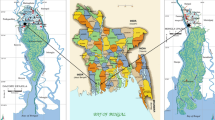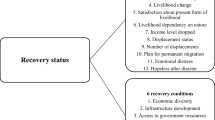Abstract
Bangladesh is a low-lying deltaic country in South Asia crossed by the Ganges, the Brahmaputra, and the Meghna Rivers. It is a land of about 159.3 million (Bangladesh Bureau of Statistics (BBS 2011) people within its 147,570 km2 territory. Due to its geographical location, Bangladesh has struggled to cope with and recover from hazards and disasters for a very long time. Disaster risk reduction is a concept created by the United Nations International Strategy for Disaster Risk Reduction (UNISDR 2004); it denotes the aim to both reduce pre facto vulnerability regarding natural disasters and increase post-factum capacity to deal with them. This study mainly focuses on strategies linked to disaster risk mitigation at the southwestern coastal region following the cyclone ‘Aila.’ The purpose of the study is to explore the effectiveness of disaster risk reduction (DRR) processes and to find the level and degree of practical implementation of said processes in southwestern coastal Bangladesh. The methodology of the study is based on both primary and secondary data. This includes interviews as well as Focus Group Discussions (FGDs) and Key Informant Interviews (KII) for collecting qualitative and quantitative data. Sociocultural and politico-environmental processes strongly affect disaster risk mitigation—it is a matter of fact that DRR can have fruitful intervention so as to overcome the adversities linked to coastal livelihood. Observations showed that household heads are the main key player for the disaster risk mitigation strategies of a cyclone-affected community, which are severely vulnerable. The study also found that DRR processes depend on the effectiveness of the mitigation strategies which in turn is largely determined by their successful acknowledgement of an adaptation to the local communities and social structures involved. The study depicts various adaptation strategies by households and by the community at large (the local community cannot be considered as conscious and proactive); all initiatives regarding disaster risk mitigation activities must involve and promote local capacities. In addition, the study addresses community perception and responsiveness to efficiencies of DRR strategies and the role of both the local government and civil society organizations (CSO) regarding DRR and mitigation processes.
Access this chapter
Tax calculation will be finalised at checkout
Purchases are for personal use only
Similar content being viewed by others
Notes
- 1.
(WAPDA/EPWAPDA formerly known as East Pakistan Water and Power development Authority. After the independence of Bangladesh, the EPWAPDA was abolished by a presidential decree, and two organizations were created in 1972: Bangladesh Water Development Board (BWDB) and Bangladesh Power Development Board (BPDB). Similar functions and charter of duties of the water wing of the erstwhile EPWAPDA were assigned to BWDB. (Source: Banglapedia)
References
Ahsan MN, Ahmed MF, Bappy MH, Hasan MN, Nahar N (2011) Climate change induced vulnerability on living standard-a study on south western coastal region of Bangladesh. J Innov Dev Strateg 5(3):24–28
BBS (2011) Population and housing census 2011. http://203.112.218.66/WebTestApplication/userfiles/Image/BBS/Socio_Economic.pdf
BCCSAP (2009) Climate change strategy and action plan, 2009. Ministry of Environment and Forest, Government of Bangladesh. Retrieved from http://www.moef.gov.bd/climate_change_strategy2009.pdf
CEGIS (2007) Investigating the impact of relative sea-level rise on coastal communities and their livelihoods in Bangladesh. UK Department for Environment Food and Rural Affairs, England
Christoplos I (2006) The elusive ‘window of opportunity’ for risk reduction. Paper presented at ProVention Consortium Forum. Bangkok, Thailand. ALNAP and Glemminge Development Research, Bangkok
Davies M, Oswald K, Mitchell T (2009) Climate change adaptation, disaster risk reduction and social protection. Organization for Economic Co-operation and Development (OECD), Paris, France
Dipecho (2011) A disaster resilient future: mobilizing communities and institutions for effective risk reduction. Disaster Preparedness ECHO, Dhaka, Bangladesh
EM-DAT (2013) Natural disasters reported 1975–2011 in Bangladesh. International Disaster Database. Université Catholique de Louvain, Belgium
Garatwa W, Bollin DC (2002) Disaster risk management working concept. Activity area emergency and refugee aid, Deutsche Gesellschaft fur Technische Zusammenarbeit (GTZ) Gmbh
Haque F (2018) Assessment of livelihood resilience in relation to cyclones and climate change along the south-western coastal belt of Bangladesh. Master’s thesis in natural resource management, specializing in geography Trondheim, Norwegian University of Science and Technology, Faculty of Natural Sciences, Department of Geography
Hasan H, Akhter S, Ahmed S, Kabir A (2013) Challenges of integrating disaster risk management and climate change adaptation policies at the national level: Bangladesh as a Case. Glob J Hum Soc Sci Geogr Geo-Sci Environ Disaster Manag 13(4):29–34
HIES (2010) Bangladesh—household income and expenditure survey 2010, Dhaka, Bangladesh
Hossen A, Ahmed SU, Abedien MZ (2009) Good practices for community resilience. Practical action—Bangladesh, Dhaka, Bangladesh. Retrieved from http://www.nasa.gov/mission_pages/hurricanes/archives/2013/h2013_Mahasen.html
IPCC (2007) Contribution of working group II to the fourth assessment report of IPCC on climate change, 2007. Impacts, Adaptations and Vulnerability, Cambridge, United Kingdom and New York, USA
Jahan I (2012) Cyclone Aila and the southwestern coastal zone of Bangladesh: in the context of vulnerability. Lund University, Sweden
Kazi S (2018) Coastal embankment improvement project—phase I (CEIP-I)—P128276—Sequence No: 10 (English). World Bank Group, Washington, D.C.
Lindell MK, Prater CS (2003) Assessing community impacts of natural disasters. Am Soc Civ Eng Libr 4(4):176–185
Mallick B, Witte SM, Sarkar R, Mahboob AS, Vogt J (2009) Local adaptation strategies of a coastal community during cyclone Sidr and their vulnerability analysis for sustainable disaster mitigation planning in Bangladesh. J Bangladesh Inst Plan 10(2):158–168
Mondal P (2010) Integrating disaster risk reduction and climate change adaptation into development program: experiences from northern chars in Bangladesh. SHOUHARDO II Program, Care Bangladesh, Dhaka, Bangladesh
Mucke P (2012) World disaster report. (2012). World Risk Index. Bündnis Entwicklung Hilft (Alliance Development Works)
Rahman M, Mokhlesur M (2013) Assessing natural disaster preparedness and climate change mitigation strategies in the coastal areas of Bangladesh. The HKU Scholars Club, Pokfulam, Hong Kong
Roy K, Kumar U, Mehedi H, Sultana T, Ershad DM (2009). Initial Assessment Report with focus on Khulna District. Unnayan Onneshan—Humanity Watch—Nijera Kori, Khulna Bangladesh
Rubiera J, Burton A, Destin D (2010) Disaster mitigation strategies. Regional specialized meteorological center (RSMC), Florida, USA
Scawthorn C (2009) Disaster management for infrastructure. In: Krishnamurthy S (ed) Disaster management—global challenges and local solutions. Universities Press Private Limited, Hyderabad
UN (2010) Cyclone Aila: joint UN multi-sector assessment and response framework, New York
UNISDR (2004) Living with risk—a global review of disaster reduction initiatives, United Nations
Zedillo E (ed) (2007) Global warming: looking beyond Kyoto. Brookings Institution Press, Washington, DC
Zimmermann M, Glombitza KF, Rothenberger B (2012) Disaster risk reduction programme for Bangladesh 2010–2012. Swiss Agency for Development and Cooperation (SDC)
Author information
Authors and Affiliations
Corresponding author
Editor information
Editors and Affiliations
Rights and permissions
Copyright information
© 2020 Springer Nature Switzerland AG
About this chapter
Cite this chapter
Roy, T., Nasreen, M., Khan, A.A., Rezaul Karim, M. (2020). Disaster Risk Mitigation Strategies in the Southwestern Coastal Region of Bangladesh. In: Bandyopadhyay, S., Pathak, C., Dentinho, T. (eds) Urbanization and Regional Sustainability in South Asia. Contemporary South Asian Studies. Springer, Cham. https://doi.org/10.1007/978-3-030-23796-7_5
Download citation
DOI: https://doi.org/10.1007/978-3-030-23796-7_5
Published:
Publisher Name: Springer, Cham
Print ISBN: 978-3-030-23795-0
Online ISBN: 978-3-030-23796-7
eBook Packages: Political Science and International StudiesPolitical Science and International Studies (R0)




